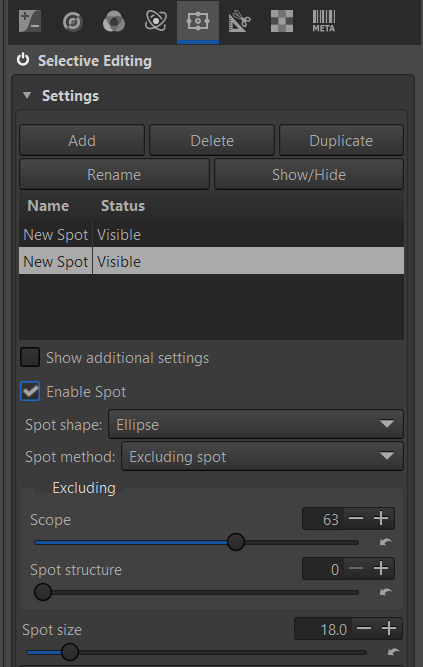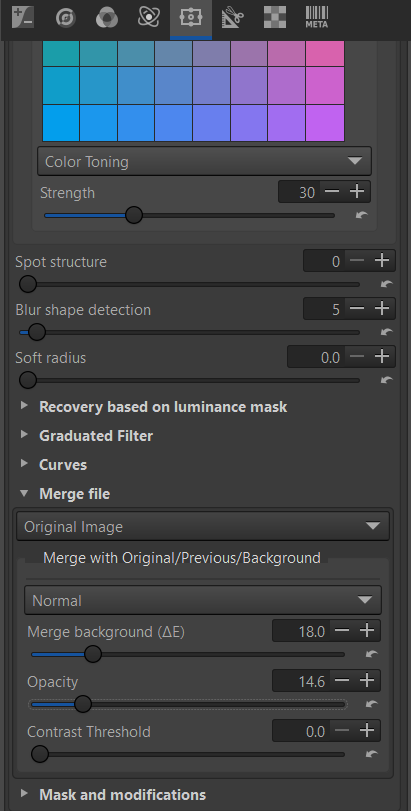@paulmatth oh, i overlooked this
Next problem:
Gimp cannot find Rawtherapee plugin for version 5.11
A few more comments on masks, excluding spots and the possibility of blurring backgrounds.
As Wayne @Wayne_Sutton mentioned, depending on the image and the nature and colors of the background, you can blur the image in full-image mode and using deltaE (scope). With one or 2 RT-spots, you can blur the whole image without affecting too much the area you want to keep.
However, this area may be affected by the blur. In this case, using “excluding spot”, by adjusting the Scope value, will enable you to recover the original image, even if it’s not always perfect.

Instead of creating a new Spot in “excluding” mode, you can also use (with a new spot) the “Merge file” tool in “Color & Light” (Advanced mode) and adjust the opacity in “Normal - Layer blend mode” and “Original Image” (this tool is self-contained and you don’t need to activate a Color & Light slider).

For mask enthusiasts, you can use Denoise’s “wavelet luminance” function (Blur/grain & denoise) to blur and use “Recovery based on luminance mask” and a mask built with “Mask and modifications” (with the limitations of the masks I’ve designed). You can see the example in Rawpedia.
Rawpedia - Exemple
But nothing is perfect ![]()
Jacques
You can translate UI yourself. You can find “language” directory under RT installed directory. In the language directory you can find “Polish” file. It is UI translation file. In the file you can find description like below.
!TP_LOCALLAB_ACTIV;Luminance only
!TP_LOCALLAB_ACTIVSPOT;Enable Spot
!TP_LOCALLAB_ADJ;Equalizer Color
!TP_LOCALLAB_AMOUNT;Amount
!TP_LOCALLAB_ARTIF;Shape detection
!TP_LOCALLAB_ARTIF_TOOLTIP;ΔE scope threshold increases the range of ΔE scope. High values are for very wide gamut images.\nIncreasing ΔE decay can improve shape detection, but can also reduce the scope.
!TP_LOCALLAB_AUTOGRAY;Auto mean luminance (Yb%)
!TP_LOCALLAB_AUTOGRAYCIE;Automatic
!TP_LOCALLAB_AVOID;Avoid color shift
!TP_LOCALLAB_AVOIDCOLORSHIFT_TOOLTIP;Fit colors into gamut of the working color space and apply Munsell correction (Uniform Perceptual Lab). Default: Munsell only.\n\nMunsell only: Fixes Lab mode hue drifts due to non-linearity when chromaticity is changed (Uniform Perceptual Lab).\nLab: Applies a gamut control in relative colorimetric. Munsell is then applied.\nXYZ Absolute: Applies gamut control in absolute colorimetric. Munsell is then applied.\nXYZ Relative: Applies gamut control in relative colorimetric. Munsell is then applied. The result is not the same as Lab.
!TP_LOCALLAB_AVOIDMUN;Munsell correction only
!TP_LOCALLAB_AVOIDMUN_TOOLTIP;Munsell correction always disabled when Jz or CAM16 is used.
!TP_LOCALLAB_AVOIDRAD;Soft radius
!TP_LOCALLAB_BALAN;ab-L balance (ΔE)
!TP_LOCALLAB_BALANEXP;Laplacian balance
!TP_LOCALLAB_BALANH;C-H balance (ΔE)
!TP_LOCALLAB_BALAN_TOOLTIP;Changes the ΔE algorithm parameters.\nTakes into account more or less ab or L*, or more or less C or H.\nNot for Denoise.
!TP_LOCALLAB_BASELOG;Shadows range (logarithm base)
!TP_LOCALLAB_BILATERAL;Bilateral filter
!TP_LOCALLAB_BLACK_EV;Black Ev
The descriptions with capital letters are keywords to indicate UI descriptions. And “!” on top of keywords means it is not translated yet. The descriptions to the right of these keywords must be translated descriptions, but they are in English because they are not translated yet.
Therefore, you translate these right descriptions into Polish and delete “!”, you can see Polish translation in UI. Even if you do not speak English, translation tools can help you.
Hello Yasuo,
Translation tools can certainly help, but the generated text needs careful examination and must be edited most of the time. In fact, I used ChatGTP as a tool to translate the last 4 years of work of @jdc. Especially with longer texts (tooltips) the AI result may be quite off. That’s where a human must jump in. I am not sure if someone who does not speak English is the right person to do this job…
I asked ChatGTP to translate this tooltip into Polish.
!TP_LOCALLAB_AVOIDCOLORSHIFT_TOOLTIP;
No idea if the following is acceptable or not (at all).
Here’s the translation into Polish:
!TP_LOCALLAB_AVOIDCOLORSHIFT_TOOLTIP; Dopasowuje kolory do gamutu przestrzeni kolorów roboczej i stosuje korekcję Munsella (Uniform Perceptual Lab). Domyślnie: tylko Munsell.
Tylko Munsell: Naprawia przesunięcia odcieni w trybie Lab wynikające z nieliniowości przy zmianie chromatyczności (Uniform Perceptual Lab).
Lab: Zastosowano kontrolę gamutu w trybie kolorymetrii względnej. Następnie stosowany jest Munsell.
XYZ Bezwzględne: Zastosowano kontrolę gamutu w trybie kolorymetrii bezwzględnej. Następnie stosowany jest Munsell.
XYZ Względne: Zastosowano kontrolę gamutu w trybie kolorymetrii względnej. Następnie stosowany jest Munsell. Wynik różni się od trybu Lab.
Certainly.
However, @Damian_J may be able to determine the validity of the result of translation with translation tools.
I will show the translation result with google translation and DeepL.
!TP_LOCALLAB_AVOIDCOLORSHIFT_TOOLTIP
DeepL:
Dopasowanie kolorów do gamy roboczej przestrzeni kolorów i zastosowanie korekcji Munsell (Uniform Perceptual Lab). Domyślnie: Tylko Munsell.Tylko Munsell: Naprawia przesunięcia odcienia w trybie Lab z powodu nieliniowości, gdy zmieniana jest chromatyczność (Uniform Perceptual Lab). Lab: Stosuje kontrolę gamutu we względnej kolorymetrii. Następnie stosowany jest Munsell. XYZ Absolute: Stosuje kontrolę gamutu w kolorymetrii bezwzględnej. Następnie stosowany jest Munsell. XYZ Relative: Stosuje kontrolę gamutu w kolorymetrii względnej. Następnie stosowany jest Munsell. Wynik nie jest taki sam jak w przypadku opcji Lab.
Google translation:
Dopasuj kolory do gamy roboczej przestrzeni kolorów i zastosuj korekcję Munsella (Uniform Perceptual Lab). Domyślnie: tylko Munsell.Tylko Munsell: Naprawia dryfty odcieni w trybie Lab spowodowane nieliniowością, gdy zmieniana jest chromatyczność (Uniform Perceptual Lab). Lab: Stosuje kontrolę gamy w kolorymetrii względnej. Następnie stosuje się Munsell. XYZ Absolute: Stosuje kontrolę gamy w kolorymetrii absolutnej. Następnie stosuje się Munsell. XYZ Relative: Stosuje kontrolę gamy w kolorymetrii względnej. Następnie stosuje się Munsell. Wynik nie jest taki sam jak Lab.
Off-topic. Look at that very last sentence:
Same as Paul.
original text: The result is not the same as Lab.
re-translation with Google translation
1st: The result is different from Lab mode.
2nd: The result is not the same as the Lab option.
3rd: The result is not the same as Lab.
![]()
Wow, this is a long discussion about masking. Can it be moved to its own thread? @paperdigits
Sure there ya go.
2 posts were split to a new topic: CTL script question
Mmmm…that is really a rash statement!
I have a miniscule bit of fame on YouTube for producing ‘how to’ videos for Darktable, ART and RawTherapee; but 80%+ of my own work is done in Lr/ACR/Photoshop; and I work for industry clients, not myself or Joe Public.
I could, equally as well, do that work in CapOne - software used by many of the world top pro commercial photographers.
ALL raw processors have their own Achilles Heels:
Lightroom/ACR has just one - a flawed demosaicing algo that shows up in around 15/20 of images. If Adobe would acknowledge, then cure, that problem; by adopting the likes of the RawTherapee approach, then Lr/ACR would be near perfect for everyone.
Darktable and RawTherapee share one problem - complexity/steep learning curve.
RawTherapee has an extra problem - a lack of masking capacity.
Darktable has another two problems - rubbish sharpening, and the stupidest ‘export out’ routine in existence.
Darktable has extra advantages with multiple module instances, and parametric/drawn mask capabilities on nearly all modules and instances.
ART is (in my mind) a hybrid of the two aforementioned FOSS editors.
All FOSS editors are epic, and ART comes out on top because it’s easier for ‘newbies’ to get their head around, and has a lot more versatility than RT because the original RT Color Correction regions have been transformed by ctl scripting.
Considering the diminutive size of the ART Dev team, it’s a miracle.
Even if you shoot on just one camera, all shots are different. And all raw editors are different in their own way.
But NONE are BETTER than all the others - though DXO PL8 and Affinity are bested by pretty much everything!
But NONE are BETTER than all the others - though DXO PL8 and Affinity are bested by pretty much everything!
Hello Andy,
Just out of curiosity…
Why do you consider DXO PL8 so bad?
Its interface, for example, is similar to ART and RawTherapee, for one ![]()
Joking aside, Its denoise tools are often considered the best on the market (yeah, there are other commercial options such as Topaz ecc, yet…)
Even its lens support is great compared to other commercial softwares on the market.
However, it has indeed many shortcomings. To date, for instance, there is not even a way to visualize a waveform, vectorscope etc
There is an interesting comparison on YouTube regarding darktable and DXO.
This being said, IMHO, for an user, aside for the wonderful open source softwares, I would opt for Lightroom for various reasons (and no, I don’t own this Adobe software myself…)
What’s so bad about the exporting routine in DT? I just enable “high quality resampling” (why is it off by default?) and then press Ctrl-E when done editing. Seems works fine.
And that works for full resolution, 16bit TIFF in the ProPhoto output space does it?
Hi Silvio,
My trial of PL8 expired last week, and I deleted it from my system.
I’ve had Pure Raw in its various guises for quite a while; and for me, PL8 has ZERO benefit over workflows such as PR4 to DT,RT or ART.
I have to wear two hats when I try software:
- People want to know if something is better than a Lr/ACR/Ps workflow 0 in that it produces better quality images.
- How much re-learning do they have to do if they are looking to leave the Adobe plan.
In my opinion, PL8 brings nothing revolutionary to the table, other than Ai Denoise, and I much prefer the deployment of that denoise using PR4. It allows you to take advantage of the excellent DXO demosaicing without having to learn anything too drastic.
PL8 does not have any facility for the advanced masking power of Photoshop, and there is an extensive list of other things that Adobe users have, but are not available in PL8.
When it comes to Ai Denoising, it is commonly understood - with the current state of play - ACR has the best Ai denoising, followed by Lightroom (NO, they are NOT the same as of today). DXO PR4 is nearly on a par, and Topaz is lagging.
You have to remember that; in part, Ai Denoise ‘re-invents’ details that basically destroyed by excessive noise and lower dynamic range in the original raw file.
How ‘faithfully’ that reinvention takes place is the measure which forms the above ranking.
If your goal is images for social media, or even jpegs for a website, your output is much smaller than the original raw, and these differences will be fairly imperceptible.
But if your goal is full resolution images for sale, or large exhibition prints, EVERY pixel in the image need to be as good as it can be.
Horses for courses, Silvio.
Seems to work for me.
I must confess I’ve never used this output format. Our of curiosity checked the export module settings - 16 bit TIFF in linear ProPhoto RGB profile is listed there.
Hi Andy,
I’m gonna say I’m not a fan of AI Denise looking at Topaz vs RT.
LR / ACR is good enough but is it really necessary especially for newer and larger cameras sensors ? I don’t think so its worth it to pay 150 EUR -200 EUR a year to Adobe.
Here is great article about it:
Following topic of RT masking its does need learning curve and it may be somewhat limited like no brush etc but I like it just needs more or sometimes less effort to get it right.
I like to use local editing on landscape shots and I didn’t yet find place where I couldn’t do mask I want RT.
ART has better masking but somehow worst denoising than RT.
Hi,
if you have examples I’d like to see them if possible – thanks!